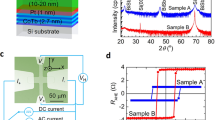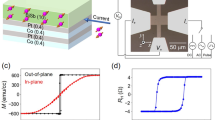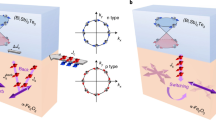Abstract
Spin–orbit torque switching using the spin Hall effect in heavy metals and topological insulators has a great potential for ultralow power magnetoresistive random-access memory. To be competitive with conventional spin-transfer torque switching, a pure spin current source with a large spin Hall angle (θSH > 1) and high electrical conductivity (σ > 105 Ω−1 m−1) is required. Here we demonstrate such a pure spin current source: conductive topological insulator BiSb thin films with σ ≈ 2.5 × 105 Ω−1 m−1, θSH ≈ 52 and spin Hall conductivity σSH ≈ 1.3 × 107 \(\frac{\hbar }{{2e}}\)Ω−1 m−1 at room temperature. We show that BiSb thin films can generate a very large spin–orbit field of 2.3 kOe MA–1 cm2 and a critical switching current density as low as 1.5 MA cm–2 in Bi0.9Sb0.1/MnGa bilayers, which underlines the potential of BiSb for industrial applications.
This is a preview of subscription content, access via your institution
Access options
Access Nature and 54 other Nature Portfolio journals
Get Nature+, our best-value online-access subscription
$29.99 / 30 days
cancel any time
Subscribe to this journal
Receive 12 print issues and online access
$259.00 per year
only $21.58 per issue
Buy this article
- Purchase on Springer Link
- Instant access to full article PDF
Prices may be subject to local taxes which are calculated during checkout



Similar content being viewed by others
References
Slonczewski, J. C. Current-driven excitation of magnetic multilayers. J. Magn. Magn. Matter 159, L1–L7 (1996).
Chang, M.-T., Rosenfeld, P., Lu, S.-L. & Jacob, B. Technology comparison for large last-level caches (L3Cs): low-leakage SRAM, low write-energy STT-RAM, and refresh-optimized eDRAM. In 2013 IEEE Proc. 19th Int. Symp. High Performance Computer Architecture (HPCA) 143–154 (IEEE, 2013).
Kato, Y., Myers, R. C., Gossard, A. C. & Awschalom, D. D. Observation of the spin Hall effect in semiconductors. Science 306, 1910–1913 (2004).
Wunderlich, Kaestner, J. B., Sinova, J. & Jungwirth, T. Experimental observation of the spin-Hall effect in a two-dimensional spin–orbit coupled semiconductor system. Phys. Rev. Lett. 94, 047204 (2005).
Miron, I. M. et al. Perpendicular switching of a single ferromagnetic layer induced by in-plane current injection. Nature 476, 189–193 (2011).
Liu, L. et al. Spin-torque switching with the giant spin Hall effect of tantalum. Science 336, 555–558 (2012).
Liu, L., Lee, O. J., Gudmundsen, T. J., Ralph, D. C. & Buhrmam, R. A. Current-induced switching of perpendicularly magnetized magnetic layers using spin torque from the spin Hall effect. Phys. Rev. Lett. 109, 096602 (2012).
Hao, Q. & Xiao, G. Giant spin Hall effect and switching induced by spin-transfer torque in a W/Co40Fe40B20/MgO structure with perpendicular magnetic anisotropy. Phys. Rev. Appl. 3, 034009 (2015).
Melnik, A. R. et al. Spin-transfer torque generated by a topological insulator. Nature 511, 449–451 (2014).
Fan, Y. et al. Magnetisation switching through giant spin–orbit torque in a magnetically doped topological insulator heterostructure. Nat. Mater. 13, 699–704 (2014).
DC, M. et al. Room-temperature perpendicular magnetization switching through giant spin–orbit torque from sputtered BixSe(1–x) topological insulator material. Nat. Mater. https://doi.org/10.1038/s41563-018-0136-z (2018).
Teo, J. C. Y., Fu, L. & Kane, C. L. Surface states and topological invariants in three-dimensional topological insulators: application to Bi1–xSbx. Phys. Rev. B 78, 045426 (2008).
Hsieh, D. et al. A topological Dirac insulator in a quantum spin Hall phase. Nature 452, 970–974 (2008).
Hirahara, T. et al. Topological metal at surface of an ultrathin Bi1–xSbx alloy film. Phys. Rev. B 81, 165422 (2010).
Nishide, A. et al. Direct mapping of the spin-filtered surface bands of a three-dimensional quantum spin Hall insulator. Phys. Rev. B 81, 041309(R) (2010).
Taskin, A. A. & Ando, Y. Quantum oscillations in a topological insulator Bi1–xSbx. Phys. Rev. B 80, 085303 (2009).
Taskin, A. A., Segawa, K. & Ando, Y. Oscillatory angular dependence of the magnetoresistance in a topological insulator Bi1–xSbx. Phys. Rev. B 82, 121302(R) (2010).
Ueda, Y., Khang, N. H. D., Yao, K. & Hai, P. N. Epitaxial growth and characterization of Bi1–xSbx spin Hall thin films on GaAs(111)A substrates. Appl. Phys. Lett. 110, 062401 (2017).
Zhu, L. J., Nie, S. H. & Zhao, J. H. Recent progress in perpendicularly magnetized Mn-based binary alloy films. Chin. Phys. B 22, 118505 (2013).
Bruno, P., Dugaev, V. K. & Taillefumieret, M. Topological Hall effect and Berry phase in magnetic nanostructures. Phys. Rev. Lett. 93, 096806 (2004).
Yasuda, K. et al. Geometric Hall effects in topological insulator heterostructures. Nat. Phys. 12, 555–559 (2016).
Ludbrook, B. M., Dubuis, G., Puichaud, A.-H., Ruck, B. J. & Granville, S. Nucleation and annihilation of skyrmions in Mn2CoAl observed through the topological Hall effect. Sci. Rep. 7, 13620 (2017).
Scharf, B., Matos-Abiague, A., Han, J. E., Hankiewicz, E. M. & Žutić, I. Tunneling planar Hall effect in topological insulators: spin valves and amplifiers. Phys. Rev. Lett. 117, 166806 (2016).
Li, P. et al. Spin–orbit torque-assisted switching in magnetic insulator thin films with perpendicular magnetic anisotropy. Nat. Commun. 7, 12688 (2015).
Kawaguchi, M. et al. Current-induced effective fields detected by magnetotransport measurements. Appl. Phys. Exp. 6, 113002 (2013).
Meng, K. K. et al. Modulated switching current density and spin–orbit torques in MnGa/Ta films with inserting ferromagnetic layers. Sci. Rep. 6, 38375 (2016).
Meng, K. K. et al. Anomalous Hall effect and spin–orbit torques in MnGa/IrMn films: modification from strong spin Hall effect of the antiferromagnet. Phys. Rev. B 94, 214413 (2016).
Ranjbar, R., Suzuki, K. Z., Sasaki, Y., Bainsla, L. & Mizukami, S. Current-induced spin–orbit torque magnetisation switching in a MnGa/Pt film with a perpendicular magnetic anisotropy. Jpn J. Appl. Phys. 55, 120302 (2016).
Pai, C.-F. et al. Spin transfer torque devices utilizing the giant spin Hall effect of tungsten. Appl. Phys. Lett. 101, 122404 (2012).
Liu, L., Moriyama, T., Ralph, D. C. & Buhrman, R. A. Spin-torque ferromagnetic resonance induced by the spin Hall effect. Phys. Rev. Lett. 106, 036601 (2011).
Han, J. et al. Room temperature spin–orbit torque switching induced by a topological insulator. Phys. Rev. Lett. 119, 077702 (2017).
Wang, Y. et al. Room temperature magnetization switching in topological insulator–ferromagnet heterostructures by spin–orbit torques. Nat. Commun. 8, 1364 (2017).
Sahin, C. & Flatté, M. E. Tunable giant spin Hall conductivities in a strong spin–orbit semimetal: Bi1–xSbx. Phys. Rev. Lett. 114, 107201 (2015).
Zhu, X.-G. et al. Three Dirac points on the (110) surface of the topological insulator Bi1−xSbx. New J. Phys. 15, 103011 (2013).
Kane, C. L. & Mele, E. J. Quantum spin Hall effect in graphene. Phys. Rev. Lett. 95, 226801 (2005).
Bernevig, B. A., Hughes, T. L. & Zhang, S.-C. Quantum spin Hall effect and topological phase transition in HgTe quantum wells. Science 314, 1757–1761 (2006).
König, M. et al. Quantum spin Hall insulator state in HgTe quantum wells. Science 318, 766–770 (2007).
Acknowledgements
This work is supported by Grant-in-Aid for Challenging Exploratory Research (no. 16K14228), and Nanotechnology platform 12025014 (F-17-IT-0011) from MEXT. The authors thank H. Iida and R. C. Roca for their help in X-ray diffraction and superconducting quantum interference device measurements. We also thank the Material Analysis Division and Laboratory for Future Interdisciplinary Research of Science and Technology at the Tokyo Institute of Technology, and M. Tanaka Laboratory at the University of Tokyo for their technical supports.
Author information
Authors and Affiliations
Contributions
N.H.D.K. grew the BiSb/MnGa bilayers, fabricated the Hall devices and performed the measurements on the bilayers; Y.U. grew and evaluated the conductivity of various BiSb layers; P.N.H. planned the experiments; N.H.D.K. and P.N.H. analysed the data and wrote the manuscript.
Corresponding author
Ethics declarations
Competing interests
The authors have filed a patent application for using BiSb as the spin current source in SOT-MRAM.
Additional information
Publisher’s note: Springer Nature remains neutral with regard to jurisdictional claims in published maps and institutional affiliations.
Supplementary information
Supplementary Information
Supplementary Figures 1–10, Supplementary Table 1, Supplementary Notes 1–6
Rights and permissions
About this article
Cite this article
Khang, N.H.D., Ueda, Y. & Hai, P.N. A conductive topological insulator with large spin Hall effect for ultralow power spin–orbit torque switching. Nature Mater 17, 808–813 (2018). https://doi.org/10.1038/s41563-018-0137-y
Received:
Accepted:
Published:
Issue Date:
DOI: https://doi.org/10.1038/s41563-018-0137-y
This article is cited by
-
Room temperature nonlocal detection of charge-spin interconversion in a topological insulator
npj 2D Materials and Applications (2024)
-
Nonvolatile magnetization switching in a single-layer magnetic topological insulator
Communications Physics (2023)
-
Room temperature energy-efficient spin-orbit torque switching in two-dimensional van der Waals Fe3GeTe2 induced by topological insulators
Nature Communications (2023)
-
Robust negative longitudinal magnetoresistance and spin–orbit torque in sputtered Pt3Sn and Pt3SnxFe1-x topological semimetal
Nature Communications (2023)
-
Field-free spin-orbit switching of perpendicular magnetization enabled by dislocation-induced in-plane symmetry breaking
Nature Communications (2023)



